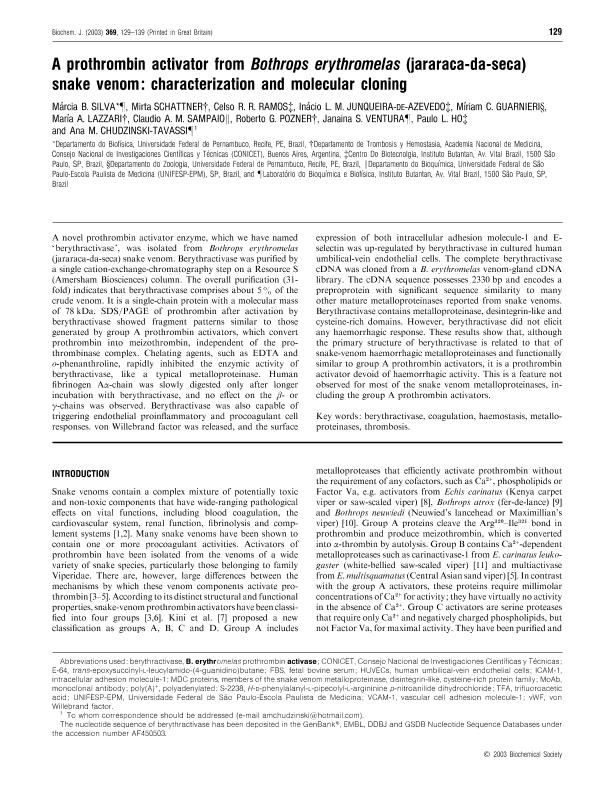Mostrar el registro sencillo del ítem
dc.contributor.author
Silva, Márcia B.
dc.contributor.author
Schattner, Mirta Ana

dc.contributor.author
Ramos, Celso R. R.
dc.contributor.author
Junqueira de Azevedo, Inácio L. M.
dc.contributor.author
Guarnieri, Míriam C.
dc.contributor.author
Lazzari, María Ángela

dc.contributor.author
Sampaio, Claudio A. M.
dc.contributor.author
Pozner, Roberto Gabriel

dc.contributor.author
Ventura, Janaina S.
dc.contributor.author
Ho, Paulo L.
dc.contributor.author
Chudzinski Tavassi, Ana M.
dc.date.available
2018-08-14T00:30:03Z
dc.date.issued
2003-01
dc.identifier.citation
Silva, Márcia B.; Schattner, Mirta Ana; Ramos, Celso R. R.; Junqueira de Azevedo, Inácio L. M.; Guarnieri, Míriam C.; et al.; A prothrombin activator from Bothrops erythromelas (jararaca-da-seca) snake venom: characterization and molecular cloning; Portland Press; Biochemical Journal; 369; 1-2003; 129-139
dc.identifier.issn
0264-6021
dc.identifier.uri
http://hdl.handle.net/11336/55306
dc.description.abstract
A novel prothrombin activator enzyme, which we have named 'berythractivase', was isolated from Bothrops erythromelas (jararaca-da-seca) snake venom. Berythractivase was purified by a single cation-exchange-chromatography step on a Resource S (Amersham Biosciences) column. The overall purification (31-fold) indicates that berythractivase comprises about 5% of the crude venom. It is a single-chain protein with a molecular mass of 78 kDa. SDS/PAGE of prothrombin after activation by berythractivase showed fragment patterns similar to those generated by group A prothrombin activators, which convert prothrombin into meizothrombin, independent of the prothrombinase complex. Chelating agents, such as EDTA and o-phenanthroline, rapidly inhibited the enzymic activity of berythractivase, like a typical metalloproteinase. Human fibrinogen Aα-chain was slowly digested only after longer incubation with berythractivase, and no effect on the β- or γ-chains was observed. Berythractivase was also capable of triggering endothelial proinfiammatory and procoagulant cell responses, von Willebrand factor was released, and the surface expression of both intracellular adhesion molecule-1 and E-selectin was up-regulated by berythractivase in cultured human umbilical-vein endothelial cells. The complete berythractivase cDNA was cloned from a B. erythromelas venom-gland cDNA library. The cDNA sequence possesses 2330 bp and encodes a preproprotein with significant sequence similarity to many other mature metalloproteinases reported from snake venoms. Berythractivase contains metalloproteinase, desintegrin-like and cysteine-rich domains. However, berythractivase did not elicit any haemorrhagic response. These results show that, although the primary structure of berythractivase is related to that of snake-venom haemorrhagic metalloproteinases and functionally similar to group A prothrombin activators, it is a prothrombin activator devoid of haemorrhagic activity. This is a feature not observed for most of the snake venom metalloproteinases, including the group A prothrombin activators.
dc.format
application/pdf
dc.language.iso
eng
dc.publisher
Portland Press

dc.rights
info:eu-repo/semantics/openAccess
dc.rights.uri
https://creativecommons.org/licenses/by-nc-sa/2.5/ar/
dc.subject
Endothelium
dc.subject
Enzyme Activator
dc.subject
Fibrinogen
dc.subject
Cell Adhesion Molecules/Drug Effects
dc.subject
Von Willebrand Factor
dc.subject
Berythractivase
dc.subject
Coagulation
dc.subject
Thrombosis
dc.subject.classification
Hematología

dc.subject.classification
Medicina Clínica

dc.subject.classification
CIENCIAS MÉDICAS Y DE LA SALUD

dc.title
A prothrombin activator from Bothrops erythromelas (jararaca-da-seca) snake venom: characterization and molecular cloning
dc.type
info:eu-repo/semantics/article
dc.type
info:ar-repo/semantics/artículo
dc.type
info:eu-repo/semantics/publishedVersion
dc.date.updated
2018-08-08T14:49:24Z
dc.identifier.eissn
1470-8728
dc.journal.volume
369
dc.journal.pagination
129-139
dc.journal.pais
Reino Unido

dc.journal.ciudad
Londres
dc.description.fil
Fil: Silva, Márcia B.. Universidade Federal de Pernambuco; Brasil. Governo do Estado de Sao Paulo. Secretaria da Saude. Instituto Butantan; Brasil
dc.description.fil
Fil: Schattner, Mirta Ana. Consejo Nacional de Investigaciones Científicas y Técnicas. Instituto de Medicina Experimental. Academia Nacional de Medicina de Buenos Aires. Instituto de Medicina Experimental; Argentina
dc.description.fil
Fil: Ramos, Celso R. R.. Governo do Estado de Sao Paulo. Secretaria da Saude. Instituto Butantan; Brasil
dc.description.fil
Fil: Junqueira de Azevedo, Inácio L. M.. Governo do Estado de Sao Paulo. Secretaria da Saude. Instituto Butantan; Brasil
dc.description.fil
Fil: Guarnieri, Míriam C.. Universidade Federal de Pernambuco; Brasil
dc.description.fil
Fil: Lazzari, María Ángela. Consejo Nacional de Investigaciones Científicas y Técnicas. Instituto de Medicina Experimental. Academia Nacional de Medicina de Buenos Aires. Instituto de Medicina Experimental; Argentina
dc.description.fil
Fil: Sampaio, Claudio A. M.. Universidade Federal de Sao Paulo;
dc.description.fil
Fil: Pozner, Roberto Gabriel. Consejo Nacional de Investigaciones Científicas y Técnicas. Instituto de Medicina Experimental. Academia Nacional de Medicina de Buenos Aires. Instituto de Medicina Experimental; Argentina
dc.description.fil
Fil: Ventura, Janaina S.. Governo do Estado de Sao Paulo. Secretaria da Saude. Instituto Butantan; Brasil
dc.description.fil
Fil: Ho, Paulo L.. Governo do Estado de Sao Paulo. Secretaria da Saude. Instituto Butantan; Brasil
dc.description.fil
Fil: Chudzinski Tavassi, Ana M.. Governo do Estado de Sao Paulo. Secretaria da Saude. Instituto Butantan; Brasil
dc.journal.title
Biochemical Journal

dc.relation.alternativeid
info:eu-repo/semantics/altIdentifier/doi/http://dx.doi.org/10.1042/BJ20020449
Archivos asociados
